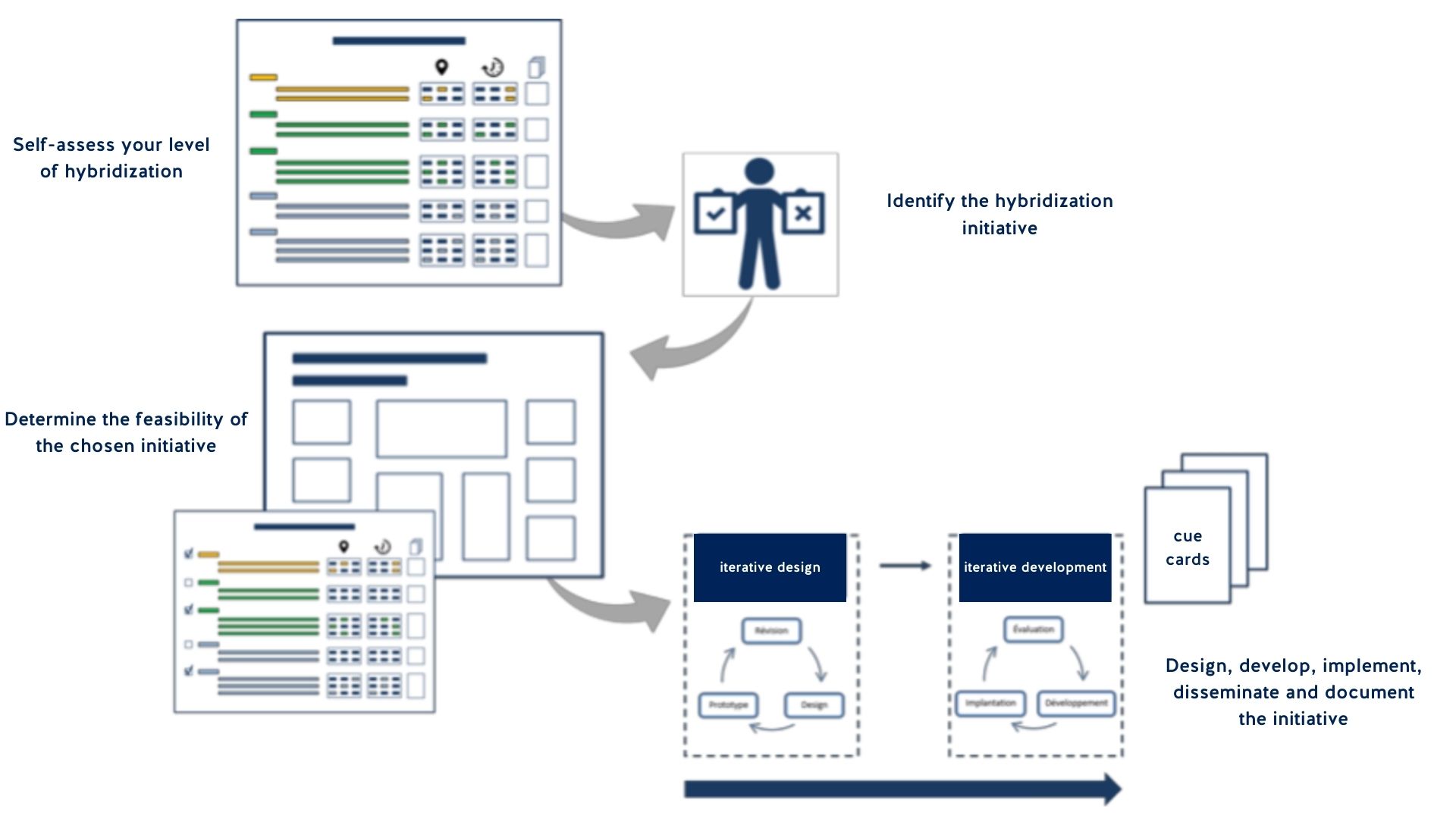

Hybridization in higher education presents a promising path to revitalize the teaching and learning experience. However, for this transition to be successful, it requires rigorous and well-structured support.

In this article, we explore a four-step process to guide higher education institutions through this transformation, emphasizing co-construction, strategic vision, and the feasibility of hybridization initiatives. This vision is inspired by the research project "Hybridization: Principles and Landmarks," by Didier Paquelin and Laurence Lachapelle-Bégin.
Self-assessment of the hybridization level is a crucial anchor point for any higher education institution aspiring to an educational transformation. This initial phase encompasses a thorough reflection on the current situation and future aspirations of the institution, its teaching unit, or its program.
Before undertaking significant changes, it is imperative to understand where the institution stands in the hybridization spectrum. This goes beyond the adoption of technologies; it's a global introspection about teaching methods, administrative structures, and existing educational culture. This initial step helps to identify the institution's strengths and weaknesses in the context of hybridization.
An inclusive approach is essential at this stage. The active participation of governance, teachers, pedagogical services, and other key stakeholders is crucial. Their collective vision provides a holistic perspective, illuminating the multiple facets of the educational ecosystem. Learners themselves can provide invaluable insights into current practices and opportunities for improvement.
|
Apprenants Bureau du/de la registraire/scolarité Conseillers/ingénieurs pédagogiques Direction des immeublespatrimoine immobilier |
Enseignants Équipe pédagogique (enseignante) Gestion des études Gouvernance (haute direction) Direction de programme Direction des technologies |
Ressources humaines Services d'aide aux étudiants Services d'orientation Services des finances Direction d'unité responsable des ressources, ex. décanat) |
Self-assessment tools provide the necessary structure to systematically evaluate the level of hybridization. They define specific categories related to hybridization, such as technological dimension, organizational maturity, administrative, pedagogical, and many others. These tools guide the institution in the comparative analysis between the current situation and the desired situation, thus laying the groundwork for the next steps in the hybridization process.
By engaging this step with rigor and active participation, higher education institutions can lay the foundations for a successful educational transition to hybridization, clearly identifying areas for development and aligning aspirations with institutional realities.
After conducting a thorough self-assessment in the first step, the higher education institution embarks on the second crucial phase of its journey towards hybridization: the identification of a specific initiative. This step aims to connect concerned stakeholders and define directions based on the previously identified level of hybridization.
The choice of the hybridization initiative is a strategic step. It must be guided by a deep understanding of the institution's current level of hybridization. This ensures that the initiative is aligned with the capabilities, resources, and organizational culture, thus avoiding significant gaps between aspiration and reality.
The selection process is not limited to choosing an initiative but also involves establishing priorities. The institution's maturity, the availability of human, financial, and technological resources, and the coherence with the strategic vision of governance are all criteria that guide the prioritization of projects. This ensures that the chosen initiative is feasible and realistic in the specific context of the institution.
The hybridization initiative can be considered according to various criteria, such as the type of target audience (e.g., those looking to balance work/family/study), the field of training, the level of education (e.g., undergraduate or graduate), or specific objectives (e.g., integration of internships). This identification must be done collaboratively, involving relevant stakeholders to ensure that the initiative is in phase with the needs and realities of the institution.
At the end of this step, the institution will have clearly defined the hybridization initiative to undertake, oriented by a deep understanding of the current level of hybridization and possibilities aligned with the institutional strategic vision.
After identifying a hybridization initiative, the institution enters a critical phase: determining the feasibility of the chosen initiative. This step, essential for the success of the project, focuses on creating added value for the involved stakeholders, evaluating the categories of hybridization affected, and ensuring the economic viability and sustainability of the project.
The central objective of this step is to evaluate the added value that the hybridization initiative brings to the concerned stakeholders, including teachers, students, and administrative staff. It is crucial to ensure that the initiative concretely and relevantly addresses an identified issue, thus improving the educational experience. This could involve transforming a specific course, a teaching unit, or even an entire program.
Specific tools are recommended for evaluating the categories of hybridization affected by the initiative. These tools help to specify the specific dimensions of hybridization impacted by the project. For example, the analysis may focus on the technological dimension, organizational flexibility, or pedagogical aspects. This in-depth evaluation helps to determine the scope and potential impact of the initiative.
At the heart of this phase, the opportunity sheet acts as a structured guide to evaluate the economic viability and sustainability of the initiative. This sheet involves the participation of all stakeholders, including learners, and uses targeted questions to illuminate the nature of the project, its relevance to the target audience, available resources, and its economic viability. The goal is to create a solid value proposition, aligned with the needs of the learners and consistent with the overall strategy of the institution.
The final step of this evaluation involves transforming any potential threats into opportunities. This might involve strategic partnerships with other institutions, identifying market niches, or innovating in how the institution approaches potential challenges. This proactive approach aims to ensure the viability and long-term success of the hybridization initiative.
At the end of this step, the institution will have a clear vision of the feasibility of the hybridization initiative, supported by rigorous evaluation tools and a deep understanding of potential opportunities and challenges. This will lay the groundwork for the successful design, development, and implementation of the initiative.
Implementing hybridization initiatives is a critical step that requires careful planning and strategic execution. This phase must consider several key elements to ensure the success and effectiveness of hybridization projects.
Each initiative must be carefully planned, with clear timelines and defined objectives. The roles and responsibilities of various stakeholders (teachers, administrators, technicians, students) must be clearly established.
Ensure the availability of material, technological, and human resources. Provide training or workshops for teachers and administrative staff to facilitate the adoption of new technologies and teaching methods.
Maintain transparent and regular communication with all stakeholders. Encourage collaboration between different departments and units to share best practices and resources.
Set up technical assistance to quickly resolve issues related to technology. Provide pedagogical support to help design and implement hybrid learning activities.
Start with pilot projects to test and refine methods before a larger-scale implementation. Regularly evaluate progress and make adjustments if necessary.
Documenting processes and outcomes is essential to trace the journey, record challenges, solutions, and feedback. Regular evaluation and reporting help to measure impacts and inform stakeholders. Disseminating knowledge through workshops, publications, or conferences is crucial to share learned lessons and best practices. Finally, continuous improvement is the driving force for the constant evolution of hybridization practices, building on feedback and evaluations to innovate and adapt teaching methods.
Source: Didier Paquelin, Laurence Lachapelle-Bégin. Hybridization: Principles and Landmarks. [Research Report] Laval University (Quebec, Canada). 2022. hal-03718900
If you are considering transforming your teaching spaces into hybrid learning environments, the ideal solution awaits you at Kalyzée. Our revolutionary comodal rooms extend the reach of training beyond traditional boundaries, offering an immersive and flexible experience for both on-site learners and those at a distance.
With complete A to Z support, Kalyzée transforms your traditional training into smooth hybrid experiences, equipped with automated equipment and easily integrable.
For more information, visit our website.